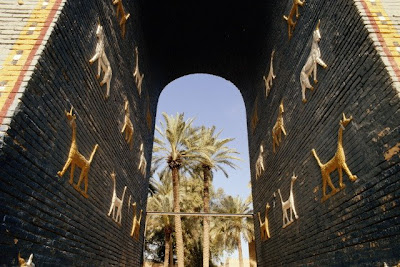Maqam Rast - Najm al-Sheikhli
Najm al-Din al-Sheikhli (1893 - 1938)
Baghdad, Iraq. 78rpm recording.
c. 1928
The Maqam Rast in the Baghdad school of music is a primary maqam based on the rast mode with its tonic on C and the first of the Rast suite. It is sung to classical Arabic verses (formerly Persian or Turkish) without rhythmic accompaniment except for two brief rhythmic interludes between the second and third meyanas. It typically includes the modulating pieces: Negriz, Mansuri, Ibrahimi, Hijaz Shaytani, Segah Balaban, Khalili, Sharqi Rast, Hijaz Madani, and Mathnawi. Poetry sung here is by the Egyptian poet Ibrahim Husni Mirza.
- Unmeasured introduction on the qanun in rast mode.
- Tahrir, unmeasured vocal introduction, presenting the rast mode to the word "yar" (love, Turkish and Persian). (0:10).
- A piece called Mansuri (saba on G). (1:00)
- A piece called Ibrahimi (bayat on G) consisting of a fragment of a verse repeated twice. (1:25)
- Jalsa, cadenza characterized by a gradual descent to the tonic sung to the word "yar", ending the first part of the maqam. (1:55)
Second part:
- First meyana called Balaban (in rast mode) sung in high register to the words "ya dust" (Arabic-Persian, my friend) followed by a verse in the same mode and a return to the tonic. (2:25)
- Dulab in sharqi rast mode and a 4/4 wahda rhythm. (3:25)
- Second meyana called Khalili (chahargah mode) to the words "nazenine men" (Persian, my honey) followed by a fragment of a verse in the same mode. (3:43)
- A piece called Sharqi Rast (in sharqi rast mode) sung to the words "ya lali, ya lali, ya ya ya dayim" (Iraqi-Arabic, oh eternal one). (4:05)
- Third meyana called Madani (hijaz mode) to the words "yademen, ya dust, meded, aman". (4:31)
- A piece called Mathnawi (hijaz mode) consisting of a sung verse followed by the command "aziz men" ('aziz, buya 'azizi used here instead) and a return to rast. (5:02)
- Taslim, conclusion of the maqam in rast mode, sung to the words "ya lail, yar", gradually descending to the tonic by way of the Negriz. (6:08)
*
نجم الدين بن عبدالله بن صفاء الدين الشيخلي ولد في بغداد في ١٨٩٣ في محلة باب الشيخ و توفي يوم الاربعاء ١٦ شباط ١٩٣٨ و دفن في مقبرة الغزالي. يعد من اساطير الغناء العراقي الديني و الدنيوي، أخذ المقام من الملا عثمان الموصلي و رحمين بن نفطار افندي و أخذ اشغال المولد النبوي من مختلف اصحاب هذه الصناعة و مجَد بصوته الشجي على مآذن الحضرة الكَيلانية و حتى وفاته كما اشتغل مع اجواق الموالد النبوية و قرأ في الذكر كثيرا. كان الناس يترددون ليلا الى مقهى عزاوي الشهير في بغداد ليستمعوا الى قرائته للمقام. و قد سجل جملة من المقامات العراقية لصالح شركات الاسطوانات الاجنبية في عشرينات القرن الماضي منها الاوج والمنصوري و الحجاز ديوان و الحجاز آجغ و الرست و المدمي و الجبوري و البهيرزاوي و المحمودي و النوى و الحويزاوي و المخالف و العجم و الطاهر و الصبا و الابراهيمي و الشرقي دوكاه و اللامي و الخنبات.
Najm al-Din bin Abdullah bin Safa' al-Din al-Sheikhli was born in the Bab al-Sheikh district of Baghdad in 1893. He learned the art of maqam from the renowned Mulla 'Uthman al-Mosuli and Rahmain bin Niftar Efendi; he also took up the religious maqam by performing heavily in Sufi dhikr and mawlid ceremonies. Older Baghdadis still remember him for his tamjid (glorification of God from minarets) during the nights of Ramadan from the Gaylani Mosque in Bab al-Sheikh. He was also famous as a pigeon-breeder and a qari' of the profane maqam music at 'Azzawi's cafe, and he recorded many maqams for both European and local record companies during the 1920s. He died in 1938 and was buried at the Ghazali cemetery of Baghdad.






Comments
Post a Comment